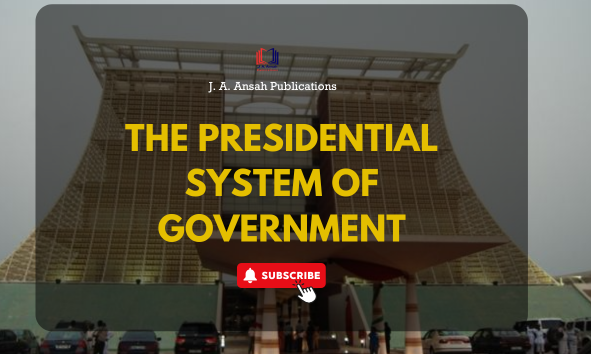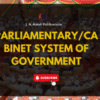THE PRESIDENTIAL SYSTEM OF GOVERNMENT
OVERVIEW
A Presidential system is a democratic and republican system of government where a head of government leads an Executive branch that is detached from the legislative branch. This head of government is in most cases also the head of state, which is called President. In Presidential countries, the Executive is elected and is not responsible to the Legislature, which cannot in ordinary situations dismiss it. Such dismissal is likely, however, in unusual cases, often through impeachment.
A Presidential system differs from a Parliamentary system, where the head of government is elected to power through the Legislature. There is also a hybrid system called semi-presidentialism.
FEATURES OF THE PRESIDENTIAL SYSTEM OF GOVERNMENT
1. The Executive arm is separate from the Legislature: A Presidential system is a democratic and republican system of government where a head of government leads an Executive arm that is separate from the legislative branch. This Head of Government is in most cases also the Head of State, which is entitled President.
2. The Executive is not accountable to the Legislature: In Presidential countries, the Executive is elected and is not answerable to the Legislature, which cannot in ordinary circumstances dismiss it. Such dismissal is likely, nevertheless, in rare cases, often through impeachment.
3. The Head of Government is directly elected by the electorate: A Presidential system contrasts with a Parliamentary system, where the Head of Government is elected to power through the Legislature. There is also a hybrid system called semi-presidentialism.
4. Single Executive: In a Presidential system of Government, one of the features is the existence of a single executive which means that the executive arm of the government is headed by a single person who is the head of state and the head of the government which means he performs both the ceremonial functions and the governmental functions; he is known as the President.
5. Fixed tenure of office: In a Presidential system of government, the President is elected for a specific term of office, which differs in states as each state has a different constitution; it could be four, five or seven years in different countries. The President is therefore elected for a constitutionally accepted fixed tenure in office. The elections which are held periodically cannot be triggered by a vote of confidence or other parliamentary procedures, however, in some states; there is provision for an exception which provides for the express removal of the President who has broken the law. The tenure of the President could be renewed after the fixed year but after the renewal, he would be let out of office.
6. Executive accountability: The President is directly elected by the people (citizens); hence he derives his mandate from the people, and he is accountable to them directly for his actions and inactions in office.
7. Recognised opposition: Another feature of the presidential system of government is that the role of the opposition is explicit; it is expressly stated by the Constitution. Party discipline is, therefore, not very strong.
8. Supremacy of the Constitution: In this system of government, the Constitution is the supreme law of the land. Anyone who exercises his powers outside the constitutional mandate is deemed to be in contravention of the constitution. Such actions would be annulled by the Judiciary.
9. Executive organ of government is unipersonal: The Cabinet ministers or executive departmental chiefs are not members of the Legislature. The President can generally direct the military, members of the cabinet, or any officer or employee of the Executive branch, but cannot dismiss the judges or direct them.
10. Checks and Balances: Another characteristic of the Presidential system of government is the principle of checks and balances. An example of Checks and Balances is the right to veto power. The President (Executive) could veto legislative acts and actions. An example of the exercise of veto power in the US is where the President can veto the Acts of the Congress, and the Legislature could remove or impeach the Federal Judges and the President of the federation respectively, while the Judiciary can declare a law an unconstitutional law through the process of Judicial Review.
11. Presidential pardon or prerogative of mercy: The President can grant pardon or prerogative of mercy to a convict who has a life sentence, death sentence or a long sentence and this is exclusively at his own discretion.
12. Power of appointment and execution: Another feature of the Presidential system of government is that the President has the power to appoint Supreme Court Justices, (the highest members of the Judiciary). Likewise, the President has the right to sign a bill into law; yet, this right is not a supreme right being that when the President refuses to sign a bill into law, the Legislature can execute such law by a two third majority of the House.
13. Real Head of the State: In this system, the Head of the State is the real
executive head.
14. Political homogeneity is not obligatory: It is not obligatory that all Cabinet members should belong to same political party.
ADVANTAGES OF THE PRESIDENTIAL SYSTEM OF GOVERNMENT
1. It is democratic: The Presidential system of government is generally viewed as democratic because, under the system, the President is directly chosen by the electorates and is therefore directly accountable to the common people.
2. Effective control by President: In a Presidential system, as the Ministers are appointed by the President, the President can successfully control them. As his direct appointees, they are accountable to him in all their deeds in the course of the performance of their duties.
3. Swift decision-making: The system enhances swift decision-making and implementation of government policies. This is so since, the President is a solitary executive and there is no need to do too many lengthy consultations before a decision is arrived at.
4. Stability of government: One of the features of the Presidential system of government is that there is a secure term of office. After the end of each tenure, the electorates must elect another person or renew the mandate of the incumbent President. Consequent to this feature, anyone interested in the presidency, patiently awaits his or her turn to have a shot at it. This therefore guarantees stability of government.
5. Relatively inexpensive to operate: In the Presidential system of government, there is only one Executive that must be catered for and as soon as that is done, that is all. This is unlike the Parliamentary system where there are two individuals constituting the Executive so the state must find resources to cater for both. This makes this system less expensive.
6. Easy to locate responsibility: In the Presidential system, it is easy to determine where responsibility lies. One man can be held responsible for any acts of commission and omissions. In fact, in Africa for example, the President is held responsible for whatever that goes wrong even if it is evidently not his fault.
7. Independence of the President: Once elected, the President is above his party and its pressure. Hence, he can decide not to subject to the whims and caprice of his party members. He stands as the symbol of one nation and the father of the nation.
8. Full control of the Executive arm: Unlike what happens in a Cabinet system where the Prime Minister is weak, in a Presidential system of government, the President has effective control of the Executive arm of the government. He the President, has the power to discipline any minister who is not performing well.
9. Political participation in politics: In a Presidential system, more people are given the opportunity to participate in government even though it may be expensive to operate. This is as a result of the fact that members of the Legislature are different from members of the cabinet.
10. It encourages good policy making: Good policies seem to be made in a Presidential system as a result of the fact that the Legislature which is a different organ approves some of the policies of the Cabinet arm and again the two organs can be controlled by different parties.
11. Absence of collective responsibility: Unlike the collective responsibility in the Cabinet system, in the Presidential system of government, every individual is accountable for his actions which may lead to his own resignation and not the entire Cabinet.
12. Separation of Powers: One of the major merits of the Presidential system is that, there is a clear separation of powers among the three organs of government which prevents misuse of powers.
13. Checks and Balances: The application of the principle of Checks and Balances in the Presidential system makes the government officials including the President cautious and meticulous in carrying out their functions which makes government very efficient and orderly.
14. Fixed term of office of the President: The system fixes a limited period for the President to rule and give chance to others and this prevents the emergence of a President who will rule for life. In Ghana for instance, the President is expected to stay in office for just 4 years. After his first term of office, he can decide to come out for another election.
DISADVANTAGES OF THE PRESIDENTIAL SYSTEM
1. It can degenerate into dictatorship: The Presidential system has the propensity to degenerate into a dictatorship. The consequence is that the rights of the citizens may be violated, the opinions of political rivals, suppressed and their individual liberties taken away from them.
2. Thin line between partisan and national issues: In a Presidential system, occasionally, it is not easy to distinguish between issues that are purely national and those that are purely partisan issues. This is because the same person represents the face of the party in power and at the same time the leader of the state.
3. Cannot change government midway: In a Presidential system, the Executive stays in power for a fixed term. The disadvantage is that if by the middle of his term of office his policies no longer favour the people, he cannot be removed unless he serves his term in full. In other words, it brings impediments to leadership change: Presidential systems often make it difficult to remove a President from office early, for instance after taking actions that become unpopular. Even if a President is proved to be inefficient, even if he becomes unpopular, even if his policy is unacceptable to the majority of his countrymen, he and his methods must be endured until the moment comes for a new election.
Parliamentary systems can swiftly remove unpopular leaders by a vote of no confidence, a procedure that serves as a “pressure release valve” for political tension. Typically, in Parliamentary systems a basic premise is that if a Premier’s popularity sustains a serious enough blow and the Premier does not as a matter of consequence offer to resign before the next election, then those Members of Parliament who would persist in supporting the Premier will be at serious risk of losing their seats.
4. Strained relationship between the Executive and Legislature: In a Presidential system, if majority of the members of the Legislature belong to a party different from that of the President, they may compete against policy proposals from the Executive. Likewise, when the Executive proposes nominees for vetting and approval by the Legislature, the nominees may be rejected by the Legislature. Alternatively, the President can also refuse to give his assent to bills from the Legislature for it to become law. This could lead to a deadlock.
5. Fixation on how to remain in power: Since there is a secure term of office for the President and periodic elections to renew mandate, the Executive may lose focus too much on winning the next election and therefore lose his focus on his core function. Also, the party of the President will be more fixated about staying in power than on the problems of the people.
6. It leads to high rate of corruption: Lobbying which is a feature of the Presidential system is interpreted by some legislators as bribery, hence legislators must wait to be bribed before passing any bill initiated by the President.
7. It is difficult to check the President: Since the President is both the head of state and a government, it may be difficult to control him. Another reason for this is because, he is not responsible to the Legislature.
8. Arbitrary dismissals: Because the President has the right to dismiss any member of his Cabinet, there is the possibility that the President will use such power as an instrument of political victimisation.



